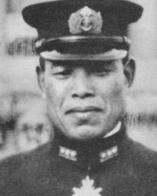Itō Seiichi
Itō Seiichi ( Japanese 伊藤 整 一 ; * July 26, 1890 in Miyama ; † April 7, 1945 off Okinawa ) was a Japanese admiral and commander in chief of the last major Japanese war effort of heavy capital ships in World War II .
Life
Start of career
In 1911 (Meiji 42) Itō graduated from the naval school. He was then used as a young officer on various ships in the Japanese Navy . In 1923 he went back to the academy and successfully completed it, so that in 1927 he could be sent to the United States for half a year . On his return he was promoted to captain and Japanese naval attaché in the Manchukuo Empire .
commander
In 1933 Itō got the command of his first ship, this was the light cruiser Kiso . This was followed by further commands for the heavy cruisers Mogami and Atago . In 1936 he was then commander of the battleship Haruna for two years .
admiral
Shortly thereafter, in 1938, Itō was promoted to Rear Admiral and he became Chief of Staff of the 2nd Fleet, but quickly switched to the post of office manager of the Navy Ministry , which he held for two years. In 1940 he was appointed Commander of the 8th Cruiser Division (CruDiv 8) and in 1941 Chief of Staff of the United Fleet Admiral Yamamoto's . In this position he was promoted to Vice Admiral.
He was hostile to the war, as did Grand Admiral Yamamoto and Admiral Toyoda Soemu . He was personally in favor of good relations with the United States , because he was afraid of the immense armaments potential of the Americans.
He had to give up his post in 1944 after he was promoted to Commander in Chief of the 2nd Fleet in the Inland Sea.
Last mission and death
During Operation Ten-gō , a relief attack for the island of Okinawa , Itō was the commander of the relief association around the battleship Yamato . His job was a kamikaze mission, because the largest battleship ever built had only stashed fuel as far as Okinawa. It is the largest kamikaze mission in world history.
His task force was approaching Okinawa, but was discovered early on. Even the Yamato could not withstand the attack of more than 300 American carrier aircraft in several waves , although it was equipped with a strong anti-aircraft armament. After various torpedo, bomb and near-bomb hits, the ship was hopelessly lost and began to capsize.
After the commandant of the Yamato received the message that there was no longer any possibility of saving the ship, Vice Admiral Itō said goodbye to the men of the bridge crew and told them to save themselves, he would stay on the ship. He should then have gone to his cabin. How he ultimately died is not known.
Posthumously he was portrayed as a hero in Japanese war propaganda and was promoted to admiral at the same time .
Web links
- Nishida, Hiroshi: Graduates of Naval Academy class 39th (English)
Individual evidence
- ↑ Russel Spurr - A glorious way to die , p. 289
| personal data | |
|---|---|
| SURNAME | Itō, Seiichi |
| ALTERNATIVE NAMES | 伊藤 整 一 (Japanese) |
| BRIEF DESCRIPTION | Commander of the Japanese fleet in World War II |
| DATE OF BIRTH | July 26, 1890 |
| PLACE OF BIRTH | Miyama , Japan |
| DATE OF DEATH | April 7, 1945 |
| Place of death | Okinawa |

